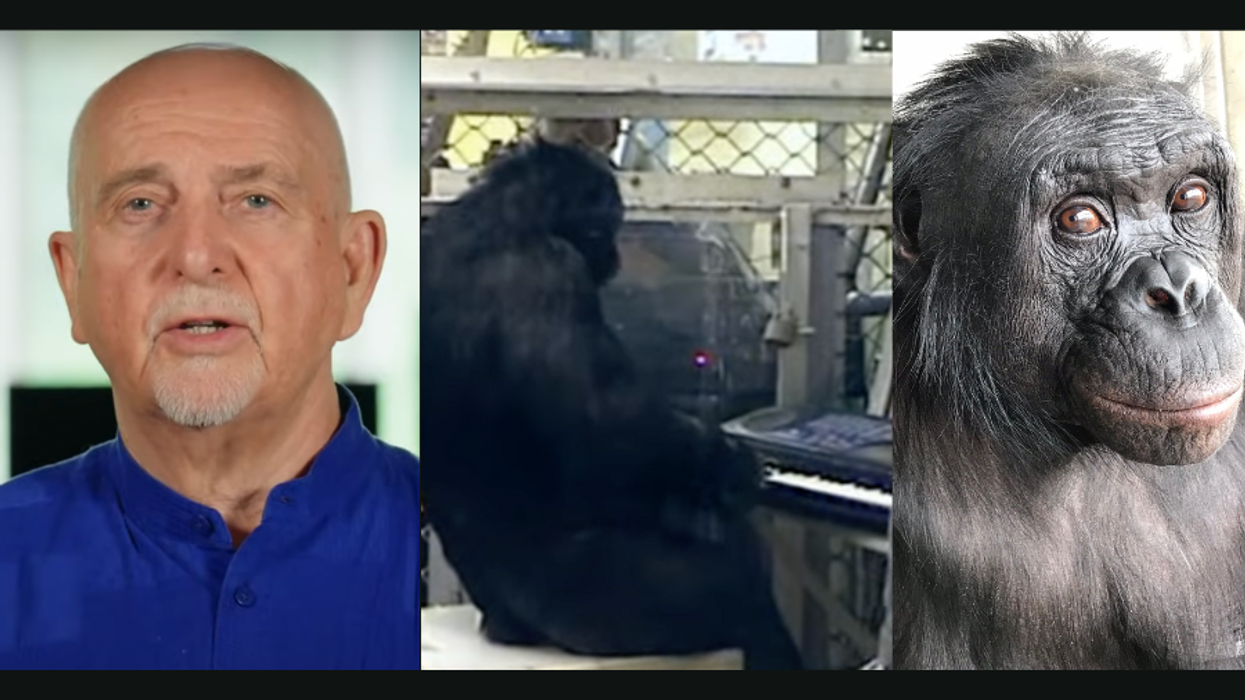On a recent visit to Wolfson Medical Center on the outskirts of Tel Aviv, Israel, Yolana Zimmerman (pictured above) is met with audible sighs of relief.
“Great! You’re here! We need you,” says a nurse.
Zimmerman is not a medical doctor. In fact, she casts quite a contrast to the typical image of a doctor with her pink leggings, cupcake apron, and eyelet bloomers—not to mention the underwear on her head and the stuffed monkey in her hands. Yolana “Yoyo” Zimmerman is part of a team of medical clowns called Dream Doctors. The pioneering organization started in 2002 with three medical clowns at one hospital and today facilitates the work of more than 110 clowns across 28 hospitals in a country increasingly recognized as the vanguard of medical clowning. After this past April’s devastating earthquake in Nepal, for instance, the Israeli government sent an envoy from Dream Doctors to Kathmandu to work with affected children. As you might expect, the medical community is taking notice of the tiny nation’s zany medical practitioners.
While the clown appears as an archetype throughout history, its societal function has varied. For the ancestors of the indigenous people of northern Australia, clowning was a way to assuage potential feuds among men. For the Tübatulabal people in the Sierra Nevada range of Southern California, clowns served the political role of announcing the need for a new chief. Among the Witoto people of southeastern Columbia and northern Peru, clowning was a strategy for drawing communal attention to individual grievances, Festivus-style. In the scheme of things, medical clowning is a relatively recent addition to this cultural history. Beginning in 1986 in New York City under the umbrella of a program called the Big Apple Circus Clown Care Unit, the practice can now be found all over the world, perhaps most notably in Israel.
[quote position="full" is_quote="true"]Yoyo directs her attention to a religious man sitting beside his daughter who is sleeping in a hospital bed. He is obviously reading from the Bible. ‘Is that a good book?’ Yoyo asks. ‘I think I’ve heard something about it. … Who wrote it again?’[/quote]
The freedom under which Israeli medical clowns are able to operate is a rarity in the field and Dream Doctors’ premium on clowning education and training, as well as hands-on involvement with medical staffs, affords it a distinct advantage over forms elsewhere in the world. Its efforts have given way to a range of research, with medical clowning at the forefront of a number of breakthrough techniques and therapeutic approaches. In Israel, clowns aren’t cheerful diversions, but are seamlessly integrated into a broad range of medical practices.
“Medical clowning has developed in Israel in a different way than anywhere else in the world,” says Professor Ati Citron, creator and director of University of Haifa’s Medical Clowning program. “Medical clowns were absorbed into the medical system as part of the staff. I’ve seen firsthand how clowns work in the United States. Even after 30 years, they [the clowns] are still not allowed to touch a patient. The fear of malpractice lawsuits dominates the whole system. The doctors are hardly aware that the clowns are even there. In Israel, there is a deep, significant difference, and that has paved the way for avant-garde practices.”
Anyone who has been hospitalized understands the loss of control experienced upon admission: Clothes become a hospital gown, trays of goop replace favorite foods, and the body is poked and prodded as if it were stripped of all humanity. The medical clown’s job is to recalibrate the situation as much as possible. Medical clowns in Israel typically work in 3-4 hour shifts 2-3 times a week. Shifts are an instant reboot that can affect a whole medical ward—nurses, doctors, patients, parents, and visitors included.
Case-in-point: Walking into an adjacent hospital room, without missing a beat, Yoyo directs her attention to a religious man sitting beside his daughter who is sleeping in a hospital bed. He is obviously reading from the Bible. “Is that a good book?” Yoyo asks. “I think I’ve heard something about it. … Who wrote it again?” The father looks up at her, grinning in surprise. In the same moment Yoyo doubles over with genuine laughter, igniting a cacophony of noises from a squeezable rooster in her apron. The rowdiness attracts a gang of kids roaming the normally quiet halls. Yoyo pretends to eat some bubble gum bubbles as we head to the neonatal intensive care unit, where she comforts new moms of preemies and aids doctors while they conduct emergency surgeries.
In Israel, medical clowns are involved in over 40 medical procedures, including accompanying patients to CT scans, X-rays, MRIs, chemotherapy, radiation treatment, physiotherapy, and rehabilitation. Clowns in Israel also work solo to initiate a more interactive, one-on-one relationship with patients. (Elsewhere they work in teams of two or in groups.) Dream Doctors, which works closely with Israel’s Ministry of Health and the University of Haifa (where students can get a bachelor’s degree in Medical Clowning), also hosts monthly workshops for the clowns where medical staff provide them with a range of medical knowledge and training on hygiene, vaccinations, before-and-after procedures for entering a room, role-playing, case studies, and more. The research it has conducted has chronicled the ways that clowning can mitigate stress and anxiety in pediatric patients, lessen the need for sedative agents in pediatric patients undergoing radionuclide scanning, and enhance the outcome for women undergoing in vitro fertilization.
[quote position="full" is_quote="true"]Before a patient even sees a doctor at the Tene Center, medical clowns meet with the abused patient at least one hour before they have to take a forensic exam.[/quote]
Michael Christensen, a.k.a. “the Godfather of hospital clowning” and founder of the Big Apple Circus Clown Care Unit, has had extensive experience working with Israeli medical clowns, both in hospitals and at international conferences. “Israeli medical clowns are totally and utterly inspirational,” Christensen tells me via email. “They have the deepest integration of clowning within the medical system [of] any ... program I have ever visited—and that integration has pushed all of us as artists to strive for the same kind of unity, collegial respect, service and communication.”
Canada-based Bernie Warren, one of the world’s leading experts on clowning in health care, had a chance to work with Dream Doctors through a Toronto symposium that he co-chaired called “A Healthy Dose of Laughter.” According to Warren, “Israeli clowns have fantastic access and opportunities within the hospital, which require no boardroom meetings or having to get permission from higher ups. ... Clowning organizations such as Le Rire Medecin in France, the Humour Foundation in Australia, and the Big Apple Circus in New York work more like theater companies that go to the hospital to perform. Israeli clowns have an entirely different approach.”
No one is more familiar with that approach than Shoshi Ofir, who works at the Tene Center at the Poriah Hospital in northern Israel. The clinic is the only one in the world to incorporate medical clowning as part of the treatment of sexually abused children and adolescents and have clowns work one-on-one with gynecologists, proctologists, and gastroenterologists to administer forensic exams. Organizations from abroad regularly visit the clinic. Last year, the Doctor Clown Association visited from Lyon, France, to shadow Ofir in hopes of applying specific approaches to its own work. “I saw how different the treatment approach is between an abused child and a clown in Israel,” explains French medical clown Blandine Thevenon Nicoli. “Not only are the clown and the doctor physically and mentally in sync, but their partnership is imperative in restoring some of the patient's integrity.”
Before a patient even sees a doctor at the Tene Center, medical clowns meet with the abused patient at least one hour before they have to take a forensic exam, which will be used as core evidence in court documents. Patients are typically 10 years old and younger, and the procedure often re-traumatizes them. During their solo time together, Ofir thoughtfully works to connect with the patient and gain his or her trust. But pre-teens are extremely sensitive and perceptive: get one word wrong and Ofir will be blocked from gaining their respect. Ofir's challenge, therefore, is to create a non-threatening environment whereupon the doctor is allowed to enter the room. Using a range of trigger codes, the doctor and Ofir work together throughout the forensic exam, with the clown remaining the patient’s unfaltering ally. If the patient is fearful, distressed, clenching his or her muscles, or uncomfortable in any way, the clown can stop the doctor from proceeding.
At Meir Medical Center in central Israel, medical clown Penny Hanuka works with pediatric patients suffering from idiopathic juvenile arthritis who must undergo corticosteroids injections into their joints. The procedure is as painful as it is stressful, especially since patients can anticipate the pain based on previous experiences. Medical clowns at Meir work with doctors using a method called “the mirror.” The doctor works on one leg while the clown works on the other leg, “mirroring” what the doctor is doing in a mock, playful, painless pantomime. Once the child is fully relaxed, the medical clown cues the doctor to start the injection. Dream Doctors’ research has shown that in these instances, not only do the children get through the procedure easier, but they also require less anesthesia. Last year, Hanuka took part in the Pediatric 2014 Rheumatology Symposium in Orlando, Florida, where she presented the research she has conducted through mirroring.
Christensen of Big Apple Circus says it's techniques like these that make the Israeli program a global model. “I hope the rest of the world pays attention,” he says. “I want every program to be as deeply integrated as the Israelis are.”




















 Music isn't just good for social bonding.Photo credit: Canva
Music isn't just good for social bonding.Photo credit: Canva Our genes may influence our love of music more than we realize.Photo credit: Canva
Our genes may influence our love of music more than we realize.Photo credit: Canva